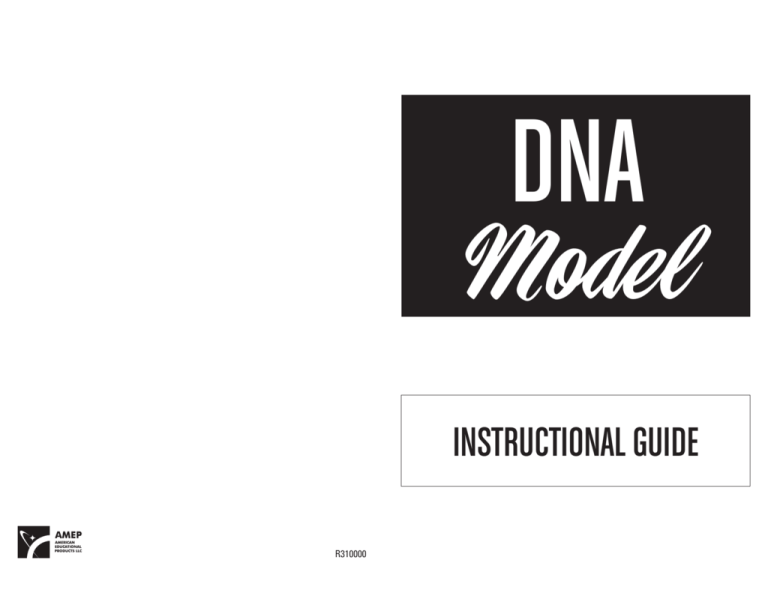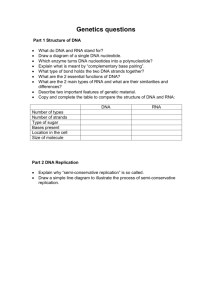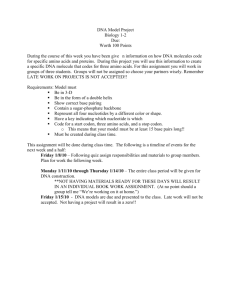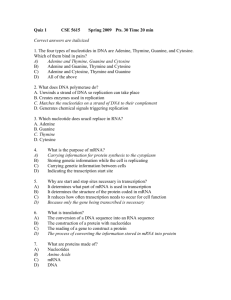
DNA
Model
INSTRUCTIONAL GUIDE
R310000
Copyright © 2013 American Educational Products, Chippewa Falls, Wisconsin All rights reserved.
The Student Guide portion of this instructional material may be reproduced by photocopy. Copies
of the guide must not be for resale or for classroom use other than by the purchaser. Additional
reproduction is prohibited without permission from the publisher: American Educational Products.
Printed in the USA.
12. A base sequence of Adenine, Adenine, Adenine (A, A, A) in mRNA would only join with
what sequence on a tRNA molecule? U U U would be the tRNA sequence to match the
mRNA sequence A A A.
13. What specific amino acid is brought to the mRNA by a tRNA molecule with the following
sequence: A, A, U? The amino acid carried by the AAU tRNA molecule would be leucine.
14. A ribosome receives the following mRNA message: AAA, GUU, GAA, and CGA.
Determine the complementary tRNA nucleotide triplets that would join the mRNA. The
complementary tRNA triplets would be UUU, CAA, CUU, and GCU.
15. What is the sequence of amino acids that those tRNA molecules would bring to the
mRNA? Those tRNA molecules would bring, in order, the amino acids lysine, valine,
glutamate and arginine.
16. What is the function of mRNA? Of tRNA? The function of mRNA is to make a copy of a
gene that can move to a ribosome so the encoded protein can be made. The function of
tRNA is to deliver to the ribosome the amino acid encoded by an mRNA sequence.
17. A mutation is a change in the DNA of an organism. How would a mutation affect the
protein made by the cell? If the DNA is changed, then the mRNA is changed. Then a
different tRNA may be needed, which would deliver a different amino acid to the ribosome.
If a different amino acid is in the protein, the shape of the protein would change. Depending
on where the change occurred, the protein might function poorly or not at all.
BACKGROUND INFORMATION
Chromosomes are structures in the nucleus of a cell and are composed of long strands of
deoxyribonucleic acid (DNA). In 1953, two scientists, James D. Watson and Francis H. C.
Crick, proposed a model of the structure of DNA. They described the molecule as a double
helix or spiral, composed of two chains of nucleotides. Each nucleotide is composed of a
molecule of the five-carbon sugar deoxyribose joined to a phosphate unit and to a nitrogencontaining base. Both strands of the DNA double helix consists of hundreds to millions of
nucleotides. Bonds between the nucleotides hold the two strands together.
There are four types of nitrogen bases, and therefore four types of nucleotides in DNA.
Two are the purines, adenine and guanine. The other two, thymine and cytosine, are
pyrimidines. These are usually represented by their first letters: A, G, T and C. The bonds
that hold the strands of the helix together involve an attraction between adenine and
thymine (A-T) and between guanine and cytosine (C-G). The attraction between these
nitrogen bases also plays a role in replication, the process by which chromosomes are
duplicated exactly in preparation for cell reproduction. During replication, the DNA strands
are “unzipped”; that is, the bonds between the A-T and C-G nucleotide pairs are broken.
Then unattached nucleotides attach to the exposed nitrogen bases and are sealed into
new “complementary” strands. As a result each of the original two strands of the double
helix has now been paired up with a new strand that is identical to the one from which it
had been “unzipped”. When a cell reproduces through mitosis, each “daughter” cell will
receive one of the newly-formed double helixes and will be genetically identical to each
other and to the original cell.
The order in which the four nucleotides occur in sections of DNA called genes determines
the sequence of amino acids in the proteins the cell can make. Sets of three nucleotides
specify specific amino acids in a code that is consistent among the various organisms on
Earth.
However, the DNA sequence is not directly involved in making proteins. A related molecule,
ribonucleic acid (RNA) is made in the first stage of protein synthesis, transcription. There
are slight differences in the nucleotide structure between DNA and RNA. RNA has the
sugar ribose instead of deoxyribose, has the nitrogen base uracil (represented by the
letter U) instead of thymine, and occurs as a single strand rather than as a double strand.
During transcription, a strand of RNA is copied from a segment of DNA (a gene). As with
replication, the attraction between the bases (A-T, U-A, G-C and C-G) is used to make the
RNA strand that is complementary to the DNA sequence. In eukaryotic cells, such as plant
or animal cells, this strand of RNA is able to leave the cell’s nucleus, while the much larger
chromosomes cannot. This RNA acts as a messenger and brings the coded nucleotides
to a ribosome, a structure in the cell’s cytoplasm where the specified amino acids are
assembled into a chain called a polypeptide or protein.
4
The triplet sets of RNA nucleotides are called “codons”. There are 64 possible codons
formed from the four RNA nucleotides (A, G, U and C). These correspond to 20 amino acids
1
and to three “stop” codons which signal the end of a polypeptide or protein chain. The
table below illustrates codons associated with the amino acids.
Amino Acid
alanine
arginine
asparagine
aspartic acid
cystine
glutamic acid
glutamine
glycine
histidine
isoleucine
leucine
lysine
methionine
phenylalanine
proline
serine
threonine
tryptophan
tyrosine
valine
Triplet Code
GCA, GCG, GCC, GCU
CGA, CGG, CGC, CGU, AGA, AGG
AAC, AAU
GAC, GAU
UGC, UGU
GAA, GAG
CAA, CAG
GGC, GGU, GGA, GGG
CAC, CAU
AUC, AUU, AUA
CUC, CUU, CUA, CUG, UUA, UUG
AAA, AAG
AUG
UUU, UUC
CCA, CCG, CCC, CCU
UCA, UCG, UCC, UCU, AGU, AGC
ACA, ACG, ACC, ACU
UGG
UAC, UAU
GUA, GUG, GUC, GUU
At the ribosome, the second stage of protein synthesis, translation, takes place. The
messenger RNA (mRNA) acts as a pattern or template for the assembling of amino acids
into the polypeptide or protein chain. The mRNA attaches to the ribosome. Other, nontemplate strands of RNA called transfer RNA (tRNA) bind to amino acids in the cytoplasm.
The tRNA molecule which has both a triplet of nucleotides complementary to the mRNA
codon (the “anticodon”) and the corresponding amino acid lines up with the mRNA codon
in the ribosome. When another tRNA molecule binds to the adjacent codon, the two amino
acids are bonded together. As the ribosome moves along the mRNA chain, the amino acid
chain lengthens. When a “stop” codon enters the ribosome, the completed polypeptide or
protein chain is released.
Thus, the DNA molecule indirectly controls the physical make-up of cells by determining
the structure of the proteins, such as enzymes, in the cell. The action of these enzymes
and other proteins, in turn, determines the functions of the cell. Since DNA controls the
function of the cell by encoding proteins and determines heredity, it is often called the
“Master Molecule”.
2
ANSWER KEY FOR DISCUSSION QUESTIONS
1. What is the general structure of the DNA molecule? The DNA molecule’s structure is a
double helix, two twisted chains of nucleotides, held together by hydrogen bonds.
2. Name the two parts of a DNA nucleotide which alternate to make the side portions, or
“backbone” of the DNA molecule. The two parts that make up the DNA “backbone” are the
deoxyribose sugar and the phosphate group.
3. Name the part of the DNA nucleotide to which a nitrogen base is attached. The nitrogen
base is attached to the deoxyribose sugar.
4.Name the parts of a nucleotide which join by a hydrogen bond to form the double strand
of DNA. The nitrogen bases of a pair of nucleotides join by a hydrogen bond
5. If there were four thymine bases on your model, how many adenine bases would there
be? There would be four adenine bases, because the adenine base attaches to a thymine
base by a hydrogen bond.
6. From top to bottom, what are the bases on the left side of the molecule you constructed?
On the right side? Answers will vary. One possible answer is that the left side would be
adenine-guanine-thymine-guanine-cytosine-adenine and that the right side would be
thymine-cytosine-adenine-cytosine-guanine-thymine.
7. When you opened the entire molecule along the hydrogen bonds, to what bases did the
left side attach? The right side? Answers will vary. Using the possible answer provided for
#6, the answer would be thymine, cytosine, adenine, cytosine, guanine and thymine would
attach to the left side, and adenine, guanine, thymine, guanine, cytosine and adenine would
attach to the right side.
8. Do the two new DNA molecules contain the same base pairs? Yes.
9. Are the two DNA molecules you now have exact copies of each other? Explain. Yes, the
pairings of the nitrogen bases ensures this.
10. Based upon this information, what are the bases of the messenger RNA molecule that
the left side of your DNA would construct? The right side? Answers will vary. Using the
possible answer provided for #6, the left side would form the RNA molecule uracil-cytosineadenine-cytosine-guanine-uracil and the right side would form adenine-guanine-uracilguanine-cytosine-adenine.
11. To build a messenger RNA molecule, in what way would you modify the materials of this
kit? To build a messenger RNA molecule one would need different colored parts to replace
deoxyribose with ribose and different colored parts to replace thymine with uracil.
3










